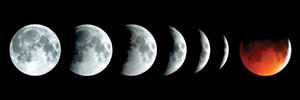How a lunar eclipse takes place
 Did
you see the lunar eclipse which took place on March 3, 2007? Were you
aware that lunar eclipses usually occur on Full Moon Poya days? Let's
look at some facts on the moon, and eclipses. Did
you see the lunar eclipse which took place on March 3, 2007? Were you
aware that lunar eclipses usually occur on Full Moon Poya days? Let's
look at some facts on the moon, and eclipses.
The Moon is a cold, rocky body about 2,160 miles (3,476 km) in
diameter. It has no light of its own, but shines by the sunlight
reflected from its surface. The Moon orbits Earth about once every 29
and half days.
As it circles our planet, the changing position of the Moon with
respect to the Sun causes our natural satellite to cycle through a series of phases: New, New Crescent, First Quarter, Waxing Gibbous,
Full, Waning Gibbous, Last Quarter, Old Crescent and back to New again.
a series of phases: New, New Crescent, First Quarter, Waxing Gibbous,
Full, Waning Gibbous, Last Quarter, Old Crescent and back to New again.
The phase known as New Moon cannot actually be seen because the
illuminated side of the Moon is then pointed away from the Earth. The
rest of the phases are familiar to all of us as the Moon cycles through
them month after month. Did you realise that the word month is derived
from the Moon's 29.5 day period?
When the Moon is full, it rises at sunset and is visible all night
long. At the end of the night, the Full Moon sets just as the Sun rises.
None of the Moon's other phases have this unique characteristic. It
happens because the Moon is directly opposite the Sun in the sky when
the Moon is full. The Full Moon also has special significance with
regard to eclipses.
An eclipse of the Moon (or lunar eclipse) can only occur at Full Moon
and only if the Moon passes through some portion of the Earth's shadow.
The shadow is actually composed of two cone-shaped components, one
nested inside the other.
The outer or penumbral shadow is a zone where the Earth blocks part
but not all of the Sun's rays from reaching the Moon. In contrast, the
inner or umbral shadow is a region where the Earth blocks all direct
sunlight from reaching the Moon.
Now you might be wondering, if the Moon orbits Earth every 29.5 days,
and lunar eclipses only occur at Full Moon, then why don't we have an
eclipse once a month during Full Moon? The reason is that the Moon's
orbit around Earth is actually tipped about 5 degrees to Earth's orbit
around the Sun.
This means that the Moon spends most of the time either above or
below the plane of Earth's orbit. And the plane of Earth's orbit around the Sun is important because Earth's shadows lie exactly in
the same plane. During Full Moon, our natural satellite usually passes
above or below Earth's shadows and misses them entirely.
orbit around the Sun is important because Earth's shadows lie exactly in
the same plane. During Full Moon, our natural satellite usually passes
above or below Earth's shadows and misses them entirely.
No eclipse takes place. But two to four times each year, the Moon
passes through some portion of the Earth's penumbral or umbral shadows
and one of the above three types of eclipses occurs.
When an eclipse of the Moon takes place, everyone on the night side
of Earth can see it. During a total lunar eclipse, the Earth blocks the
Sun's light from reaching the Moon. Astronauts on the Moon would then
see the Earth eclipsing the Sun. (They would see a bright red ring
around the Earth as they watched all the sunrises and sunsets happening
simultaneously around the world!) While the Moon remains completely
within Earth's umbral shadow, indirect sunlight still manages to reach
and illuminate it.
However, this sunlight must first pass deep through the Earth's
atmosphere which filters out most of the blue coloured light.
The remaining light is a deep red or orange in colour and is much
dimmer than pure white sunlight. Earth's atmosphere also bends or
refracts some of this light so that a small fraction of it can reach and
illuminate the Moon.
Unlike solar eclipses, lunar eclipses are completely safe to watch.
You don't need any kind of protective filters. It isn't even necessary
to use a telescope. You can watch the lunar eclipse with nothing more
than your own two eyes.
If you have a pair of binoculars, they will help magnify the view and
will make the red coloration brighter and easier to see. A standard pair
of 7x35 or 7x50 binoculars works fine. Remember to dress warmly and
enjoy the spectacle!
Compiled by Janani Amarasekara
****
Moon within the
Earth's shadow...
* The Moon has no light of its own. So why doesn't it become
invisible when it is completely within the Earth's shadow during a total
lunar eclipse?
Answer: The Moon does not usually become so dark as to become
invisible during a total lunar eclipse because some sunlight is bent to
it (through refraction) by the Earth's atmosphere. The refracted light
gives the Moon a reddish hue.
Only rarely does the Moon become totally dark. This happens when the
Earth's atmosphere is exceptionally cloudy or if there has been a
volcanic eruption and there is a lot of volcanic dust in the atmosphere.
In such conditions, no sunlight is able to pass into the Earth's shadow.
* Is it dangerous to watch a lunar eclipse?
Unlike solar eclipses, lunar eclipses are perfectly safe to watch. No
protection for the eye is required when watching a lunar eclipse. |
